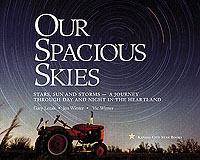
• Astrnomy Observing Tips - Page 116
• Get to know the sky with star charts and a planisphere, which is a map of the night sky with an aid to indicate which part is visible at various times and seasons.
• Go as far from city lights as possible. The dome of light pollution can extend far beyond your neighborhood.
• Use a red light! Cover a flashlight with red cellophane or red nail polish. Cover or turn off interior car dome lights. White light will ruin your dark-adapted vision and make it harder to see faint objects. One glimpse of white light can take 20 minutes to recover from.
• Even moderate-power binoculars reveal hundreds of celestial objects. When purchasing a telescope, buy the best equipment you can afford. You needn’t buy the most expensive right away, but remember: In telescopes, quality matters.
• Take snacks; observing is hard work!
• Small folding tables are handy for placing observation equipment.
• If you are observing in a field, take along a small tarpaulin to place under you and your equipment. Not only does it make dropped items easy to find, but also it’s good protection from bugs and dew.
• Find a local astronomy society or club. Members typically are eager to help you learn to explore the sky. Clubs hold regular meetings where you can meet other stargazers and learn about astronomy as a pastime.
• Visit a public star party. Club newsletters and the internet are filled with opportunities to look at the sky in the company of experienced amateurs. Many clubs offer public programs through their observatories or at meeting places. You can hear a talk about astronomy and look through telescopes, guided by volunteers.
• Dress warmly. Even summer nights in the country can get quite cool.
• Bring insect repellent during warm weather.
• Take a comfortable outdoor chair so you can appreciate the sky longer.
• Choose a safe location — and do not trespass.
• Don’t forget to bring the kids!
— Vic and Jen Winter |